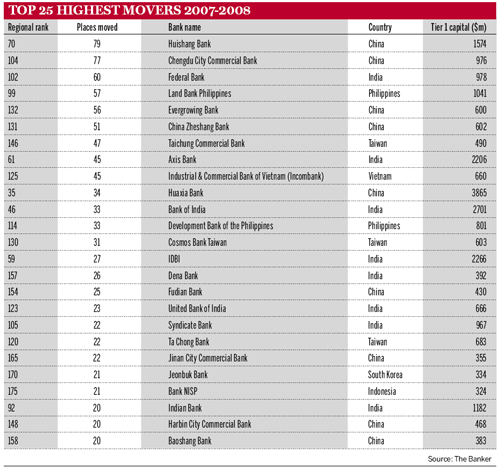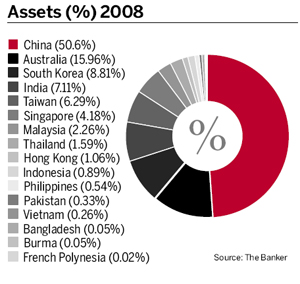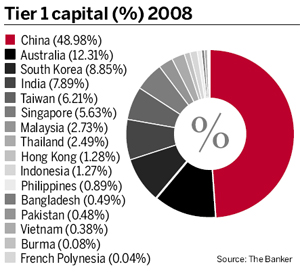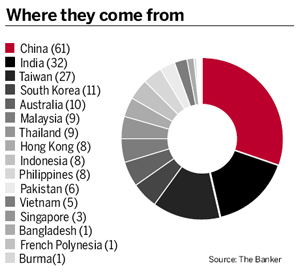Standing strong: China has continued to grow as a financial centre despite the global economic turbulence
The growth of the Asian banking sector continued in 2008, with China building on its dominance in the region, dwarfing India's more modest growth path, while South Korean banks' share declined. Writer Geraldine Lambe
The Asian Development Bank's (ADB) recent growth figures suggest that Asia has proved pretty resilient to the global slowdown. In a September report, the ADB stated that the economic expansion of Asia is expected to rise to 3.9% this year, supported by the region's larger economies of China and India, which are expected to reach 8.2% and 6%, respectively.
The composition of The Banker's Top 1000 World Banks ranking shows that the region's economic dynamism is also translating to a more decisive role for Asia's banks in the global financial system. As the number of US and European banks in the listing slides - from 185 US banks two years ago to 159, and from 279 banks from the €27 to 258 - the number of Asian banks continues to rise: two years ago there were 174 banks in the Top 1000; this year there are 193.
The success of Asia is writ large in China. Our ranking of the Top 200 Asian banks shows that China's banks are continuing to consolidate their dominance of the region's banking system. Across virtually every metric in The Banker's database, China's banks are on top.
There are now 61 banks from China in the Top 200 Asian banks, up from 46 last year and nearly twice as many as its nearest rival, India, with 32. In terms of Tier 1 capital, China's banks represent nearly half of the Asian total, at 48.98%, up from 41% in the 2008 ranking. This dwarfs the next biggest banking system, Australia, which represents just 12.31% of Asia's aggregate Tier 1 capital. In terms of assets, too, Chinese banks represent just over half of the Asian banking system, with 50.6% of the total, up from 44% last year and way ahead of Australia's 15.96%.
India's banks are also continuing a steady, if more modest, growth path. Their percentage of the region's Tier 1 capital rose from 7% in 2008 to 7.89% this year and in total assets from 7% to 7.11%. Similarly, the number of Indian banks in the Asian Top 200 ranking has crept up, from 30 banks to 32, and it boasts eight of the region's highest movers, second only to China's nine. Crucially, India's largest privately owned bank, ICICI, leapt up the rankings by 10 places this year, making it into the top 20 banks for the first time.
A different story
By contrast, South Korea's banks are losing ground in the rankings. The country's two biggest players, Kookmin Bank and Woori Financial Group, both slid down the rankings, Kookmin from eighth place to 14th and Woori from 11th place to 15th. This is reflected in their declining share of the Asian banking system. As a percentage of the region's Tier 1 capital, South Korea's banks have dropped from 13% last year to only 8.85% this year, and in total assets from 12% last year to 8.81% in 2009.
This is perhaps a signal that analysts' warning last year, that many of South Korea's banks' were heavily exposed to the export sector and to struggling small and medium-sized enterprises, have to some degree played out. There are rising non-performing loans (NPLs) at most of South Korea's banks and the country's Financial Supervisory Service recently responded by telling banks that they must take action; it says that NPLs should make up less than 1% of outstanding credit by the end of the year. South Korean banks may face a challenging second half of 2009 as they try to achieve this target.
Around the corner
But if some pessimists are proved right, South Korea's problem with NPLs may be a drop in the ocean compared with those waiting to emerge in China. Since December 2008, about $1500bn has been flooded into China's economy via the country's banks. ICBC alone has expanded its loan book by 18.9% (or $127bn) since the end of last year. Despite such explosive loan growth, the bank's net interest income fell by 12%, compared with the same period in 2008, because of the country's historically low interest rates.
While ICBC is still looking very strong - tangible common equity is a healthy 5% of total assets and loans are only 58% of deposits - such figures beg the question of how far Chinese banks can go to meet government targets. In a June report from Fitch Ratings, the agency warned that future losses on stimulus money could turn out to be larger than expected.
With the Chinese government determined to meet its growth targets, Fitch says banks have been given an implicit government guarantee to go on a huge spending spree, but if loans begin to turn bad, it is unclear how much central or local governments will be willing, or able, to bear.






